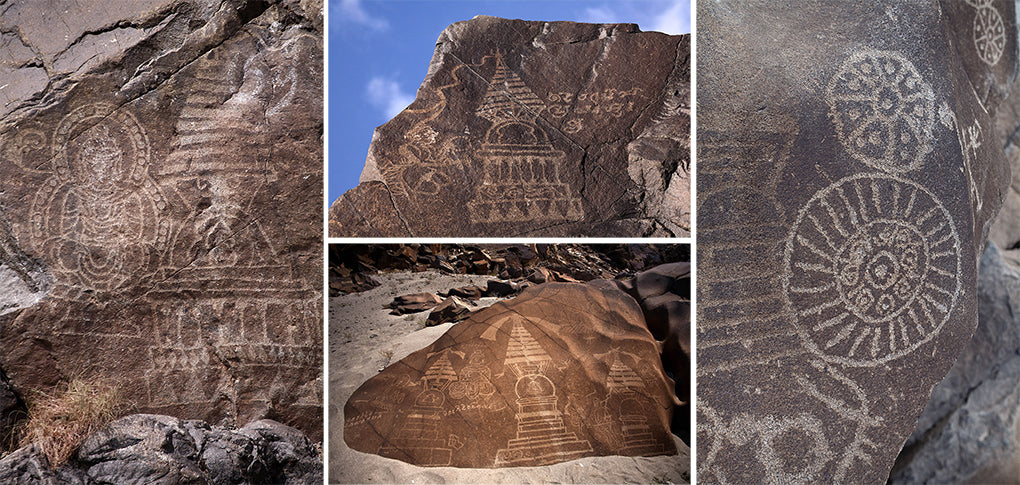
The Spiritual Significance of the Chilas Rock Carvings: A Historical Exploration
Share
Nestled in the heart of Gilgit-Baltistan, the Chilas valley is home to one of the most remarkable collections of ancient rock carvings in the world. These petroglyphs, etched into the rugged cliffs and boulders along the banks of the Indus River, are more than mere artistic expressions. They are sacred testaments to the spiritual journeys and cultural heritage of the tribes who once thrived in this region.
The Spiritual Connection to Chilas Rock Carvings
For the ancient tribes of the Chilas valley, these carvings were not just depictions of daily life or symbols of religious devotion. They were sacred imprints of their spiritual beliefs, connecting them to the divine and the natural world around them. The images of animals, triangular men, and Buddhist stupas found on these rocks were deeply symbolic, representing the tribes’ reverence for the forces of nature and their understanding of the cosmos.
The spiritual significance of these carvings is profound. Many depict Buddha and other religious figures, indicating the spread of Buddhism through this region. These carvings were often created by travelers, monks, and pilgrims who traversed the ancient Silk Road, leaving behind spiritual messages and blessings etched in stone. Each carving tells a story of faith, offering insights into the spiritual practices that shaped the lives of those who once walked these lands.
A Glimpse into History and Heritage
The Chilas rock carvings offer a unique glimpse into the history of the region. Dating from 8,000 BCE to the 16th century CE, they document the passage of time and the evolution of cultures. From the early nomadic tribes to the influence of Buddhism and the later arrival of Islam, these carvings encapsulate the rich tapestry of Chilas' past.
As a critical crossroads on the ancient Silk Road, the Chilas valley witnessed the convergence of various cultures and beliefs. Merchants, pilgrims, and artisans from Central Asia, China, and the Indian subcontinent passed through this region, leaving behind their mark on the rocks of Chilas. The diversity of languages found in the inscriptions—from Brahmi to Tibetan—highlights the valley's role as a melting pot of ideas and spiritual traditions.
The Urgency of Preservation
The spiritual and historical significance of the Chilas rock carvings cannot be overstated, yet they face an uncertain future. The construction of the Diamer Basha dam threatens to submerge many of these priceless artifacts under the waters of the new reservoir. While efforts are underway to document and preserve some of these carvings, the loss of the original sites would be a profound blow to the cultural heritage of the region.
This situation underscores the importance of preserving our shared history. The carvings of Chilas are not just relics of the past; they are living connections to the spiritual and cultural roots of the people of Gilgit-Baltistan. Protecting these carvings is not only about safeguarding art but also about honoring the spiritual significance they hold for the descendants of those who created them.
Embracing the Spiritual Legacy
For those of us who may never visit the Chilas valley, the lessons from these ancient carvings remain relevant. They remind us of the deep connection between spirituality and nature, a connection that transcends time and place. The people who carved these images into stone understood that the natural world is not separate from the spiritual but is an integral part of it.
In our modern lives, we can draw inspiration from the Chilas rock carvings by seeking our own spiritual connections with nature. Whether through meditation, mindful walks, or simply taking a moment to appreciate the beauty around us, we can find ways to reconnect with the earth and our spiritual selves. The carvings of Chilas teach us that spirituality is not confined to temples or rituals; it is woven into the very fabric of our existence and the natural world we inhabit.
As we continue to explore the rich heritage of the Chilas valley, let us also remember to live beautifully, honoring the wisdom of the past while embracing the present with mindfulness and reverence.
photo credits: https://dialogue.earth/



